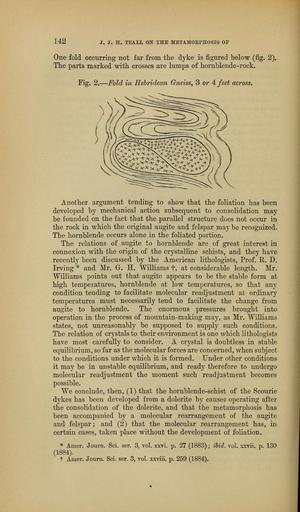MAKE A MEME
View Large Image

| View Original: | The_Quarterly_journal_of_the_Geological_Society_of_London_(14053291386).jpg (1183x2018) | |||
| Download: | Original | Medium | Small | Thumb |
| Courtesy of: | commons.wikimedia.org | More Like This | ||
| Keywords: The Quarterly journal of the Geological Society of London (14053291386).jpg 142 <br> J J H TEALL OlSr THE METAMOEPHO SIS OE <br> One fold occurring not far from the dyke is figured below fig 2 <br> The parts marked with crosses are lumps of hornblende -rock <br> Fig 2 ” Fold in Hebridean Gneiss 3 or 4 feet across <br> Another argument tending to show that the foliation has been <br> developed by mechanical action subsequent to consolidation may <br> be founded on the fact that the parallel structure does not occur in <br> the rock in which the original augite and felspar may be recognized <br> The hornblende occurs alone in the foliated portion <br> The relations of augite to hornblende are of great interest in <br> connexion with the origin of the crystalline schists and they have <br> recently been discussed by the American lithologists Prof E D <br> Irving and Mr Gr H Williams t at considerable length Mr <br> Williams points out that augite appears to be the stable form at <br> high temperatures hornblende at low temperatures so that any <br> condition tending to facilitate molecular readjustment at ordinary <br> temperatures must necessarily tend to facilitate the change from <br> augite to hornblende The enormous pressures brought into <br> operation in the process of mountain-making may as Mr Williams <br> states not unreasonably be supposed to supply such conditions <br> The relation of crystals to their environment is one which lithologists <br> have most carefidly to consider A crystal is doubtless in stable <br> equilibrium so far as the molecular forces are concerned when subject <br> to the conditions under which it is formed Under other conditions <br> it may be in unstable equilibrium and ready therefore to undergo <br> molecular readjustment the moment such readjustment becomes <br> possible <br> We conclude then 1 that the hornblende-schist of the Scourie <br> dykes has been developed from a dolerite by causes operating after <br> the consolidation of the dolerite and that the metamorphosis has <br> been accompanied by a molecular rearrangement of the augite <br> and felspar ; and 2 that the molecular rearrangement has in <br> certain cases taken place without the development of foliation <br> Amer Journ Sci ser 3 vol xxyi p 27 1883 ; ihid vol sxvii p 130 <br> 1884 <br> t Amer Joiirn Sci ser 3 vol xxviii p 259 1884 37046986 114009 51125 Page 142 Text 41 http //www biodiversitylibrary org/page/37046986 1885 Geological Society of London Biodiversity Heritage Library The Quarterly journal of the Geological Society of London v 41 1885 Geology Periodicals Smithsonian Libraries bhl page 37046986 dc identifier http //biodiversitylibrary org/page/37046986 smithsonian libraries Information field Flickr posted date ISOdate 2014-04-30 Check categories 2015 August 26 CC-BY-2 0 BioDivLibrary https //flickr com/photos/61021753 N02/14053291386 2015-08-26 04 59 33 cc-by-2 0 PD-old-70-1923 The Quarterly journal of the Geological Society of London 1885 Photos uploaded from Flickr by Fæ using a script | ||||